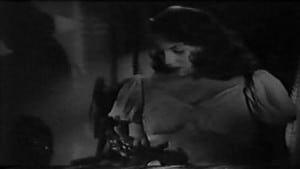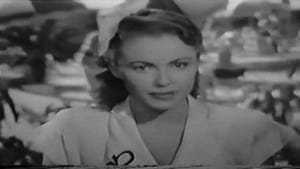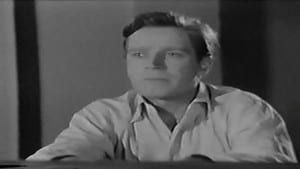Time Stopped in Its Tracks….When She Pulled the Trigger!
Released by Eagle-Lion Films, a short lived studio of the late 1940s, Repeat Performance is among their first films. Though there are those that would object to labeling Eagle-Lion a Poverty Row studio (which according to the technical definition they are not), their penchant for low budget films after their initial releases and deals to reissue films of others (including Rank and Selznick) clearly put them there. As it is among the studio’s earliest releases, Repeat Performance skews more as a light “A” or perhaps an “AB” picture.
Production values are a bit light but the cast sports hints of Hollywood stardom, with Louis Hayward and Joan Leslie in the starring roles. The film is perhaps best known for being the film debut of Richard Basehart, though it also sports Natalie Schafer (Mrs. Howell of Gilligan’s Island fame) in a minor supporting role.
After a completely overwrought introductory them by George Antheil, the picture opens with actress Sheila Page (Joan Leslie) standing over the body of her husband Barney (Louis Page), a gun, warm from its recent firing, still in her hand. Panicking, she heads through the traffic of New Year’s Eve 1946 to a friend’s house for consolation or even advice. One the stairs to his apartment- where he too is hosting a New Year’s Eve party, we notice that her hair and her dress have changed.
As she enters to see her friend John Friday (Tom Conway), she’s confused to find herself wearing a dress she hasn’t worn in months and alone with John. Where are all the other revelers? John explains the Sheila and Barney are hosting the New Year’s Eve party and with surprising ease tells Sheila that in fact it is New Year’s Eve of 1945.
 In one of the flaws of the picture, it is surprisingly easy for Sheila to be convinced that time has turned back an entire year, but no matter. She realizes now that she has an entire year to change Barney’s fate and avert his untimely death.
In one of the flaws of the picture, it is surprisingly easy for Sheila to be convinced that time has turned back an entire year, but no matter. She realizes now that she has an entire year to change Barney’s fate and avert his untimely death.
Now back in the first hours 1946 (at the Page’s party), we realize that Barney is a struggling playwright, with one success under his belt. But in his struggle to find another hit, he has turned to the bottle, and it is clear that he and Sheila have discussed this many times throughout the past.
As Barney slurs and teeters among his guests, Sheila comes to William Williams (Richard Basehart), a poet and friend, but a mentally troubled young man. Know full well that in the last 1946 he ended up committed to an insane asylum, she tries to warn him. She also gives little warnings to others, but focusses most of her efforts on saving her husband.
 As the year progresses, we find Barney going down a path of destruction. His drinking increases heavily as his career opportunities continue to diminish. Out of frustration he latches on to another woman before taking a nasty and temporarily paralyzing fall. By film’s end, we realize that destiny doesn’t change, just the manner in which it is fulfilled (or not) is open to debate.
As the year progresses, we find Barney going down a path of destruction. His drinking increases heavily as his career opportunities continue to diminish. Out of frustration he latches on to another woman before taking a nasty and temporarily paralyzing fall. By film’s end, we realize that destiny doesn’t change, just the manner in which it is fulfilled (or not) is open to debate.
Repeat Performance is definitely noir, though not of the highest caliber. The sets look thin and the feature is leaden with a talky (some have said soapy) middle third which threatens to sink the entire enterprise, though the first and final thirds make up for it.
There is a cliched narrator, who thankfully we only hear twice and both in the early few minutes. His second patch of dialogue is painfully intrusive and unnecessary, but any presaged ideas of a continual presence can safely be put aside.
 Of more consistent annoyance is the woeful score, which starts out on bad footing during the opening credits. Unfortunately it doesn’t get any better, attempting at times to sound like Rozsa and at other times Herrmann, but never developing any style of its own and remaining out of touch with the on screen drama.
Of more consistent annoyance is the woeful score, which starts out on bad footing during the opening credits. Unfortunately it doesn’t get any better, attempting at times to sound like Rozsa and at other times Herrmann, but never developing any style of its own and remaining out of touch with the on screen drama.
Joan Leslie is almost pervasively dynamic here, carrying most scenes with a powerful intensity which is uncharacteristic for most of her portrayals. Perhaps due to resentment (or vindication at working again) after a messy separation from Warner Brothers, she is consistently entrancing throughout. Though many find that her performance pales in light of the rest of the cast, I find that hers is the one which keeps the whole listing beast afloat.
 For Louis Hayward Repeat Performance marked another entry in a busy career in the years immediately after his return from the war in the Pacific. He too is strong, though particularly so in the early goings. In honesty to Hayward, much of the weakness his portrayal has in the latter reels is a result of an increasingly manic character as written. If anything, he is guilty of simply being a bit too over the top at the end, chasing after one woman and then the other with widened eyes and flaring nostrils.
For Louis Hayward Repeat Performance marked another entry in a busy career in the years immediately after his return from the war in the Pacific. He too is strong, though particularly so in the early goings. In honesty to Hayward, much of the weakness his portrayal has in the latter reels is a result of an increasingly manic character as written. If anything, he is guilty of simply being a bit too over the top at the end, chasing after one woman and then the other with widened eyes and flaring nostrils.
In the years following the film, both Hayward and Leslie would make pictures with decreasing frequency, with Hayward leaving for the less exciting- but perhaps more financially rewarding- roles characterized by television. Joan Leslie too would leave Hollywood for the most part for a sporadic career on television. Always one to demur when roles of immorality or questionable ethics were presented, she chose to focus on her family for many years.
 Basehart alone among the more significant players was on the upswing of his career. Now known mainly for his role in television’s Voyage to the Bottom of the Sea he was a dynamic player on both the large and small screen, announcing the closing ceremonies of the 1984 Olympics shortly before his death in the same year.
Basehart alone among the more significant players was on the upswing of his career. Now known mainly for his role in television’s Voyage to the Bottom of the Sea he was a dynamic player on both the large and small screen, announcing the closing ceremonies of the 1984 Olympics shortly before his death in the same year.
With a bit too many unneeded gyrations and perhaps one too many twists, we can’t put Repeat Performance in among the list of top flight noir films. Any fans of noir- especially any of the die-hard variety, will enjoy it. There is even something of the fantastic in it as well with its time traveling angle as well. Great!
